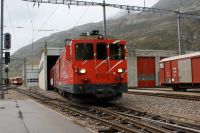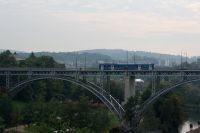Gotthardtunnel
Posted: 29 September 2009
| Taken: | 2009-09-28 19:50:14 |
|---|---|
| Camera: | Canon EOS 1000D |
| Exposure: | -1/3 |
| ISO: | 200 |
| Aperture: | f/8.0 |
| Exposure Time: | 1/125 |
| Focal Length: | 55 mm |

This work is licensed under a Creative Commons Germany license.
Notes
The railway line through the Gotthard mountain with the Gotthard tunnel as the counterpoint was opened in 1882, when the international european railway network already existed in many areas. Nevertheless, it is probably the most important line for european railroading ever, as it was the first and still is the most important useful, all-year available answer to the 2,000 year old question: How do I come from Italy (and the economic area of the Mediterranean) to Germany (and the economic areas of the North and Baltic sea)?
Among other things, the huge traffic through the line also led the swiss government to invite other european governments to the swiss capital of Berne, to create a comprehensive set of standards for rolling stock, as incompatible vehicles were quite a problem in international traffic then (1877). The contract about the “Technische Einheit im Eisenbahnwesen” (technical standardization in railroading) was abolished in 1999, but modern UIC standards, the COTIF agreement and most recently the TSIs, which are technically EU law but also applied in many non-member countries, can all trace their roots back to this.
The mountainous lines towards the Gotthard tunnel (known as the Gotthard ramps) are spectacular, but with high gradients also a problem in international freight traffic. Hence, a new Gotthard Basistunnel is currently being built, much further down the mountain and much longer. Whether the current historic line will remain is currently not clear. There are hopes for UNESCO world heritage status, which it certainly deserves in my opinion.
The train appearing here at the north end of the tunnel in Göschenen is hauled by a classic Re 4/4II. This InterRegio from Lugano to Basel has just about every type of single-decker passenger car you’ll find in Switzerland, including EW I from the 1960s, EW IV from the 1980s, EuroCity carriages in Cisalpino paint scheme and even a panorama car with raised floor and huge windows. As I neither know too many railroad car enthusiast, nor am one myself, I decided to ignore this, though.

 Deutsche Version
Deutsche Version Entire Gallery
Entire Gallery

 Next Picture
Next Picture
 Previous Picture
Previous Picture
